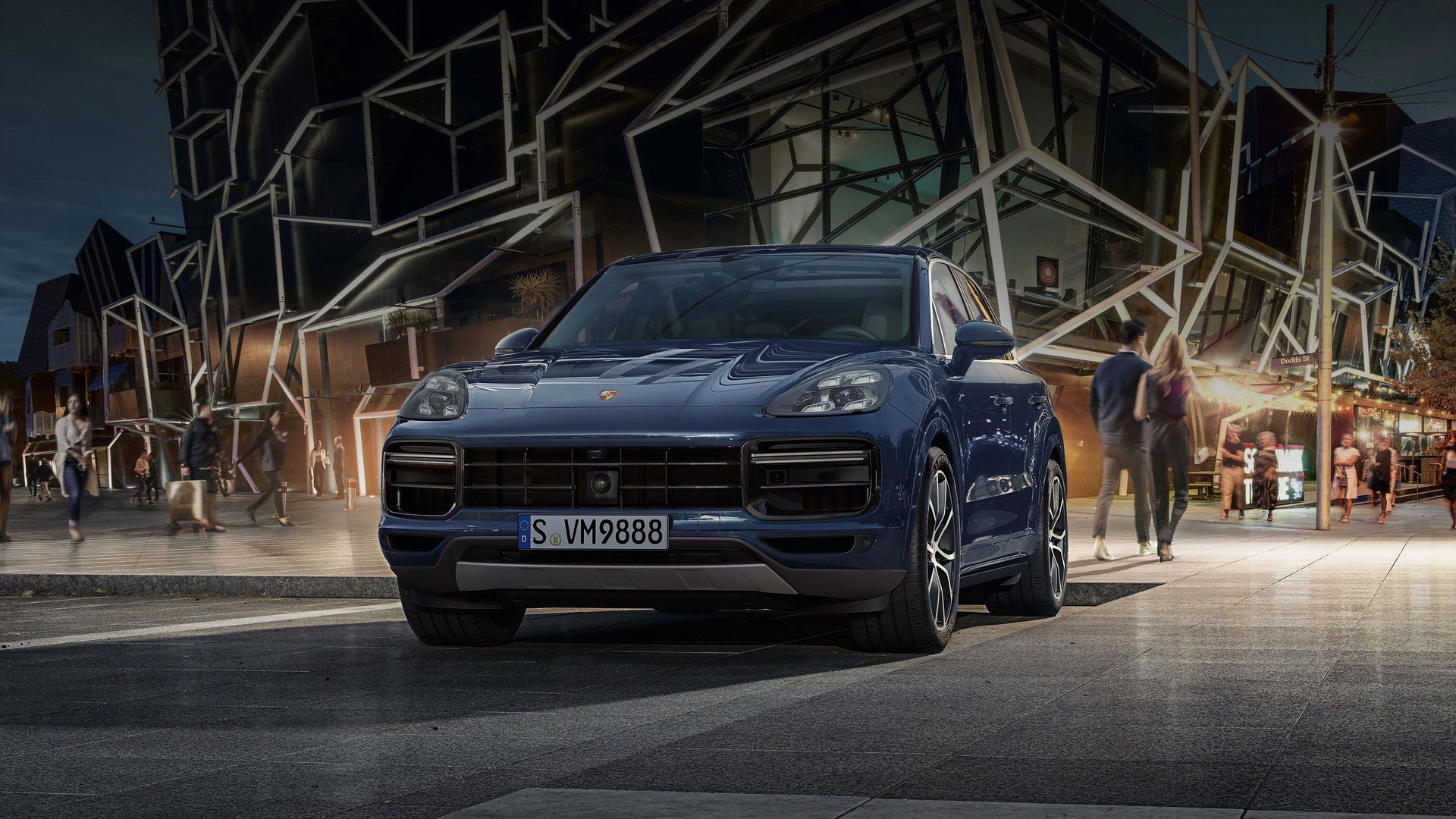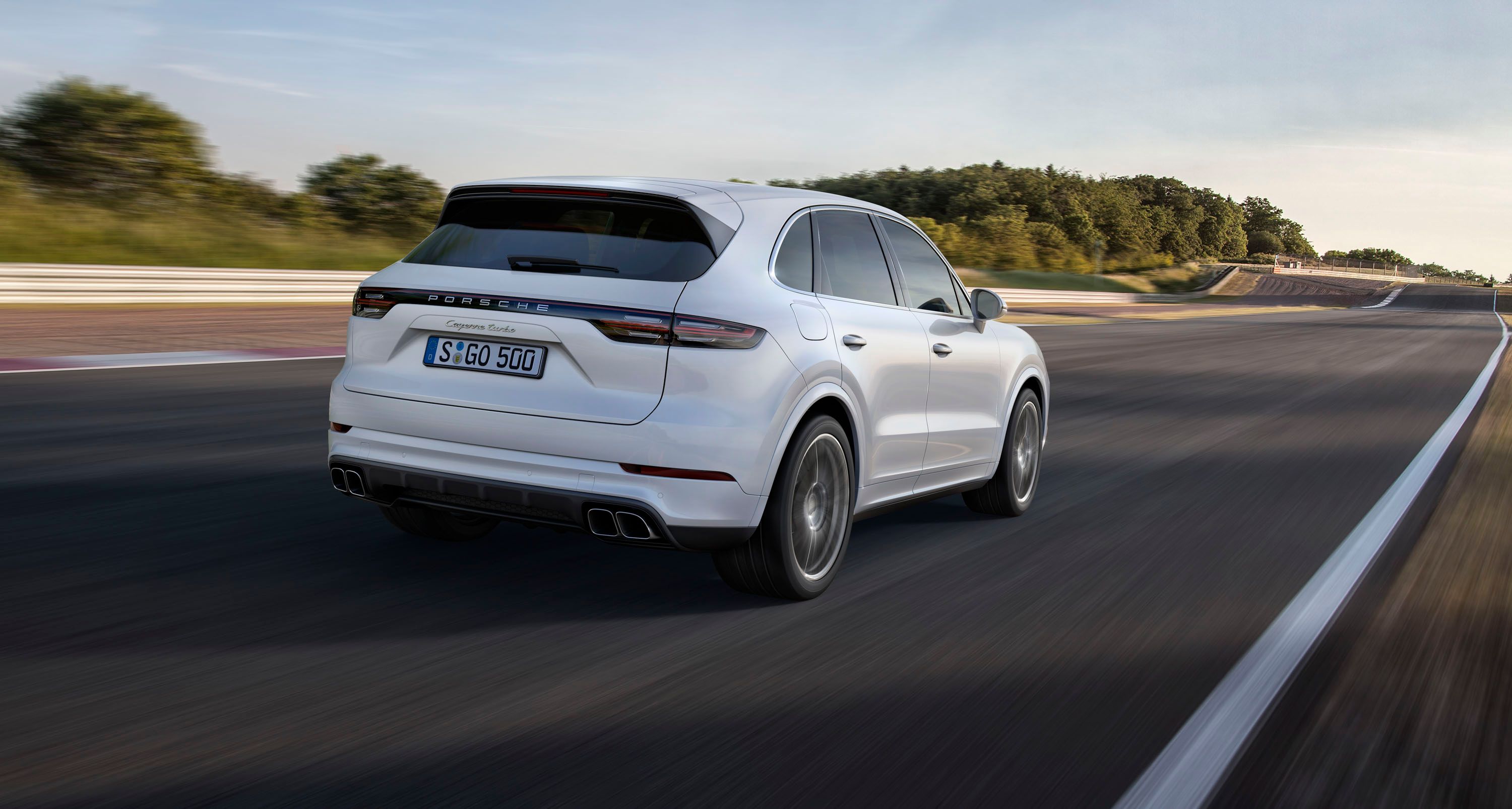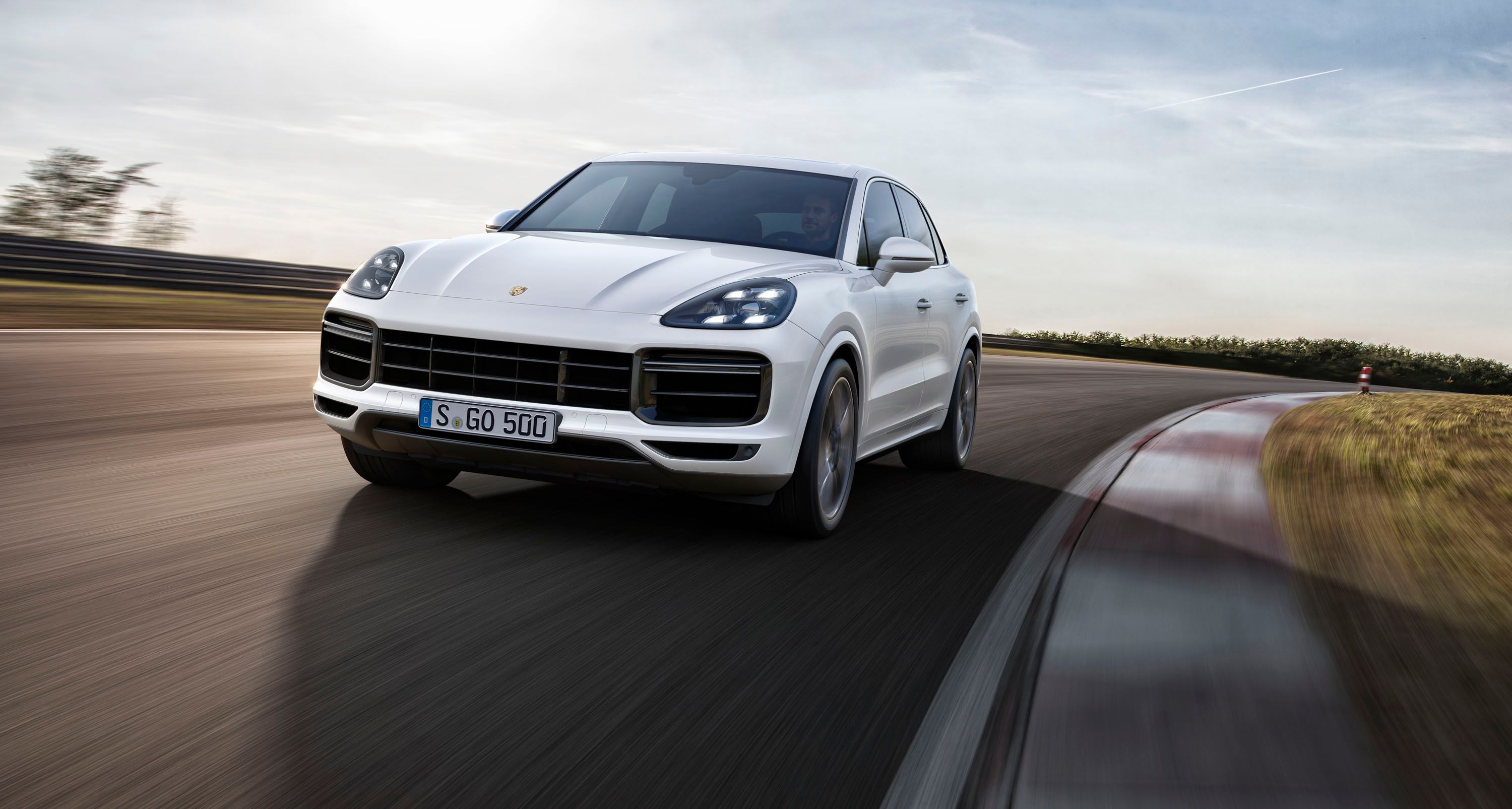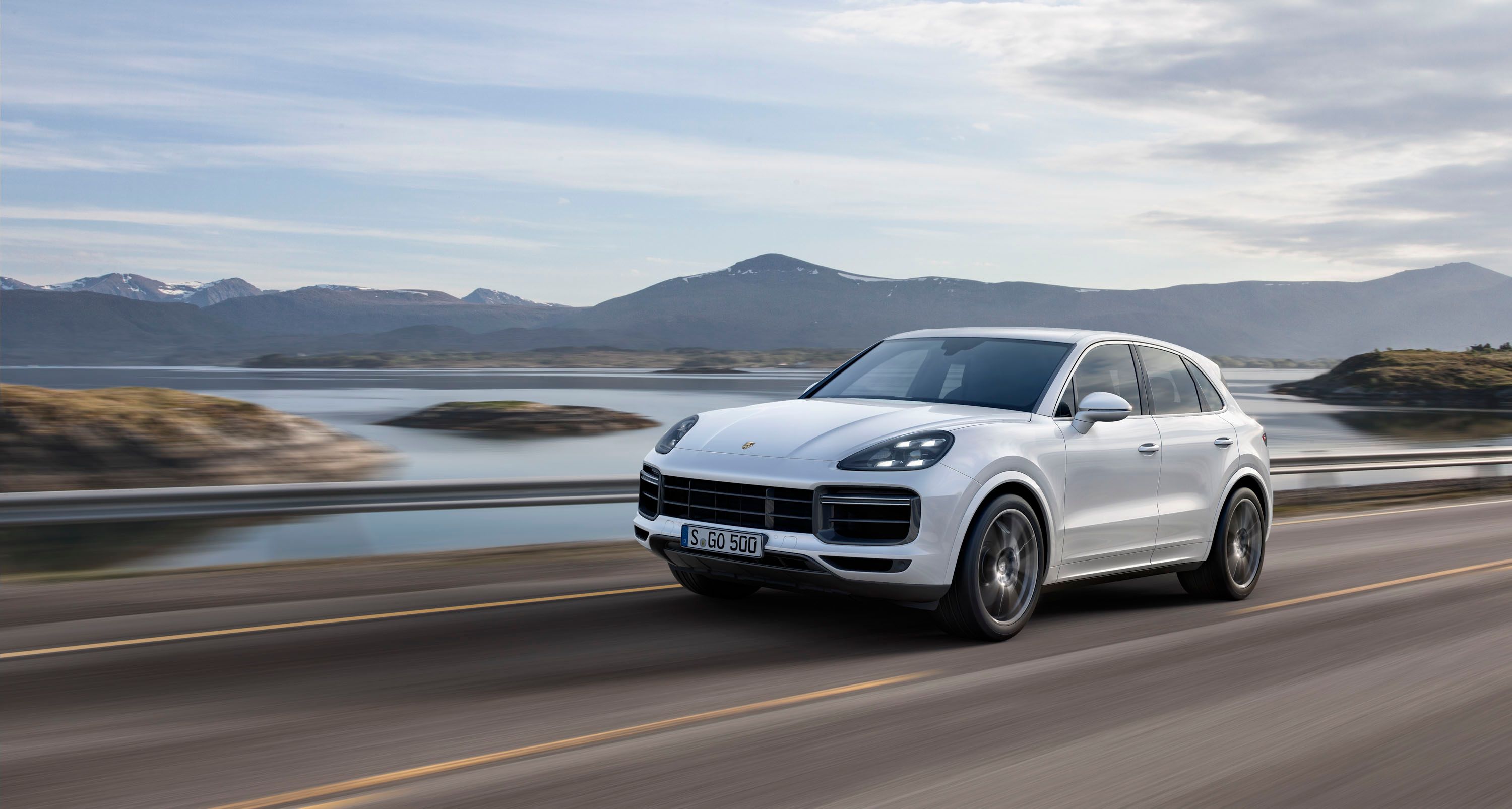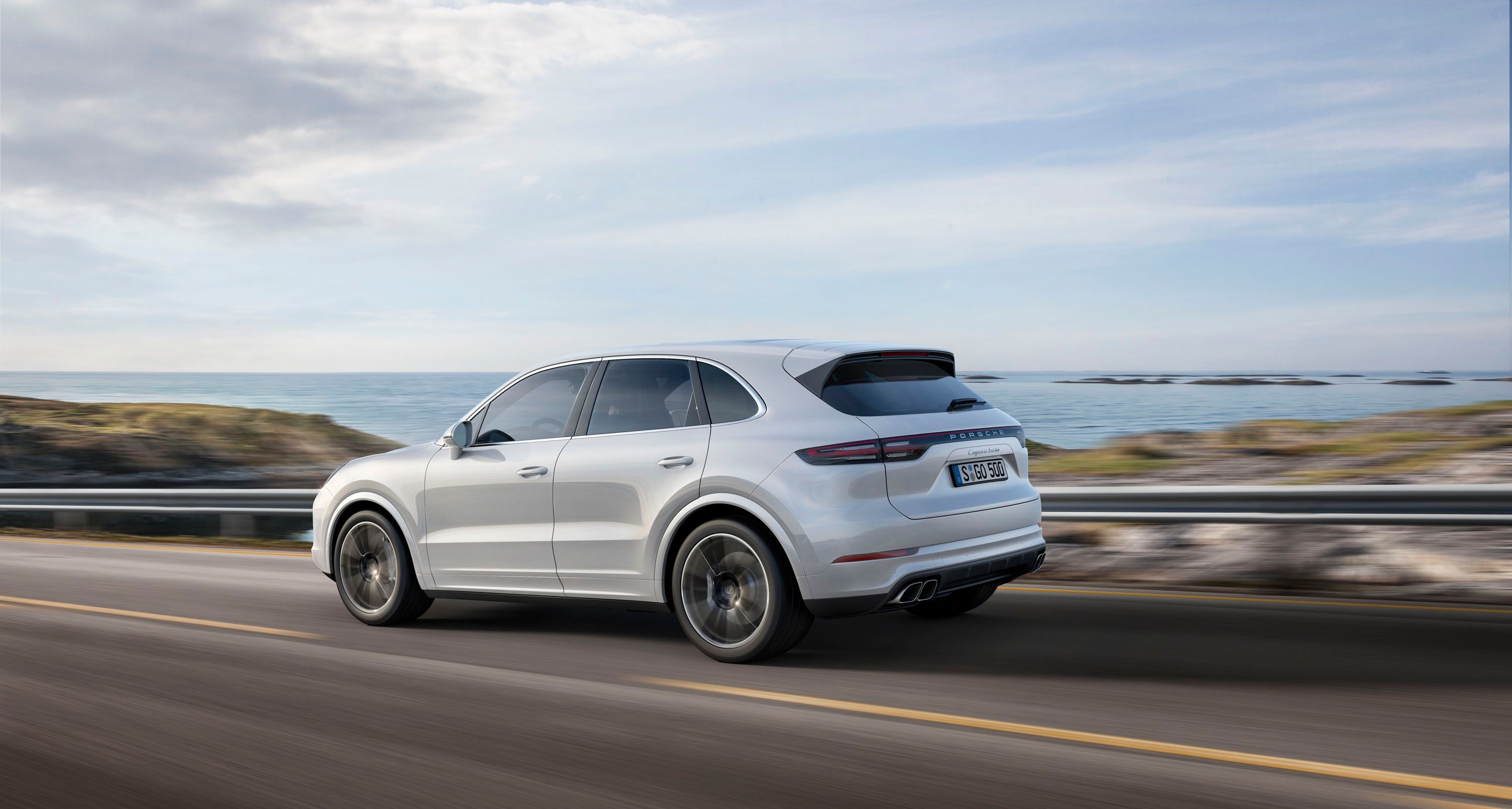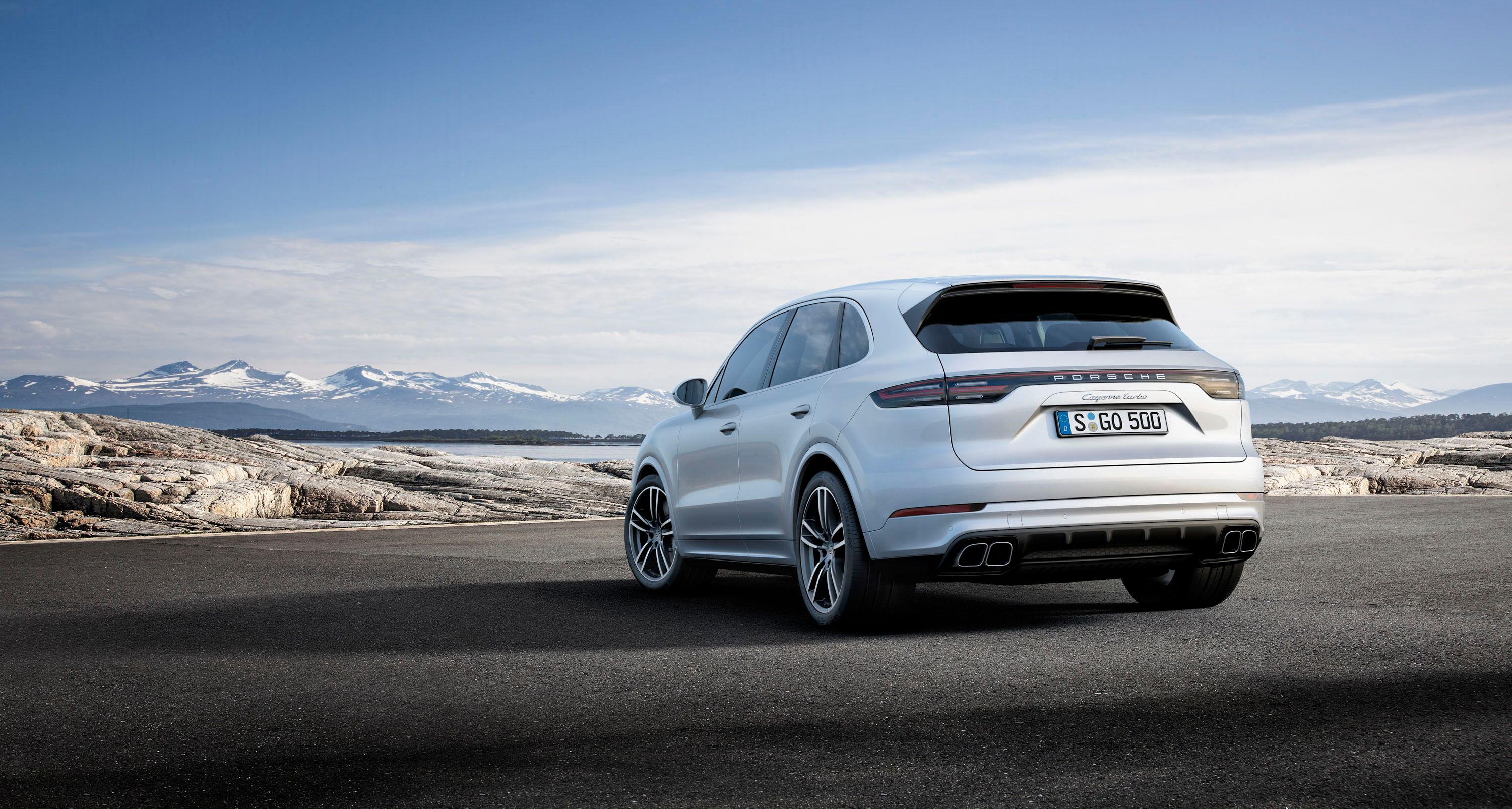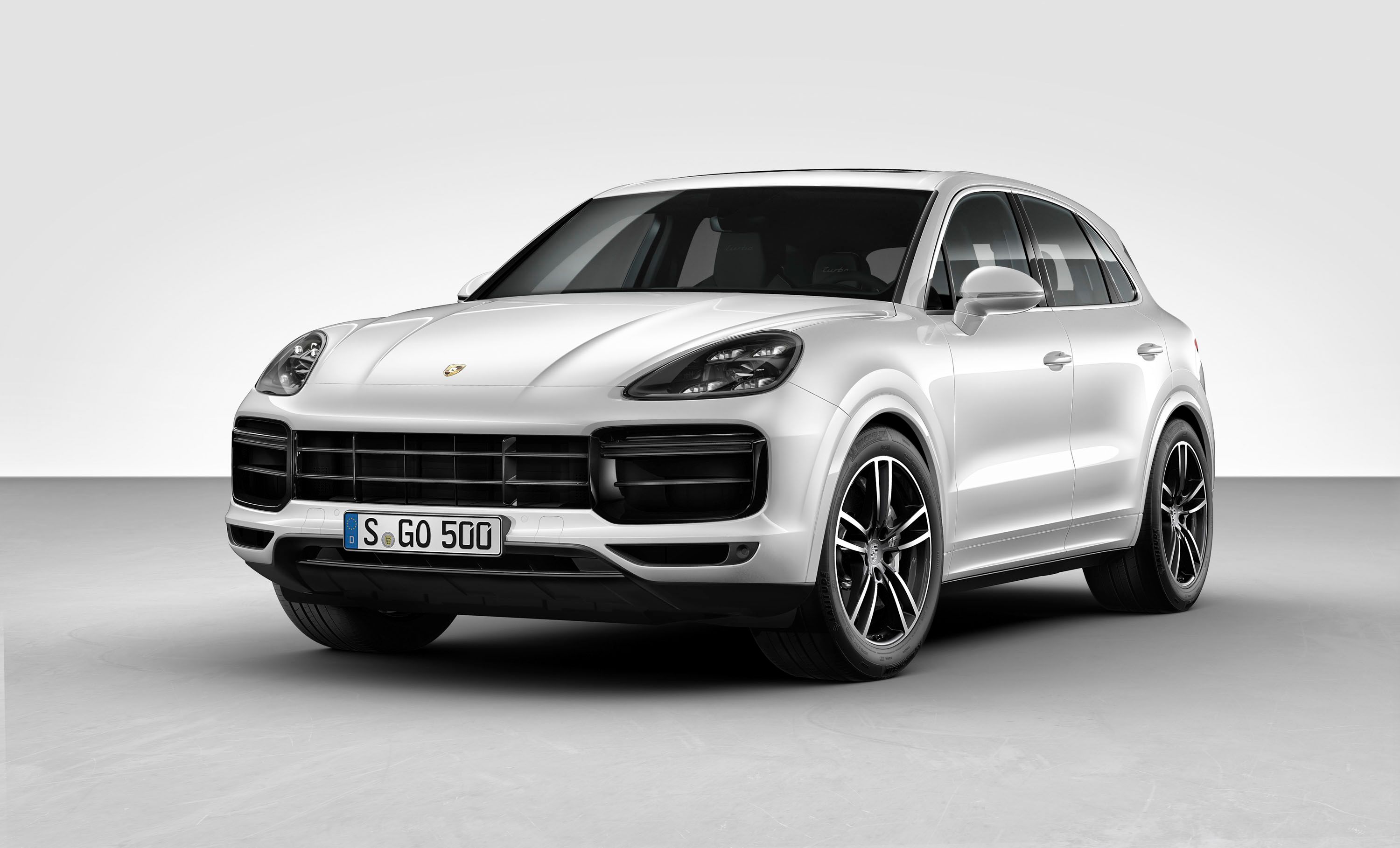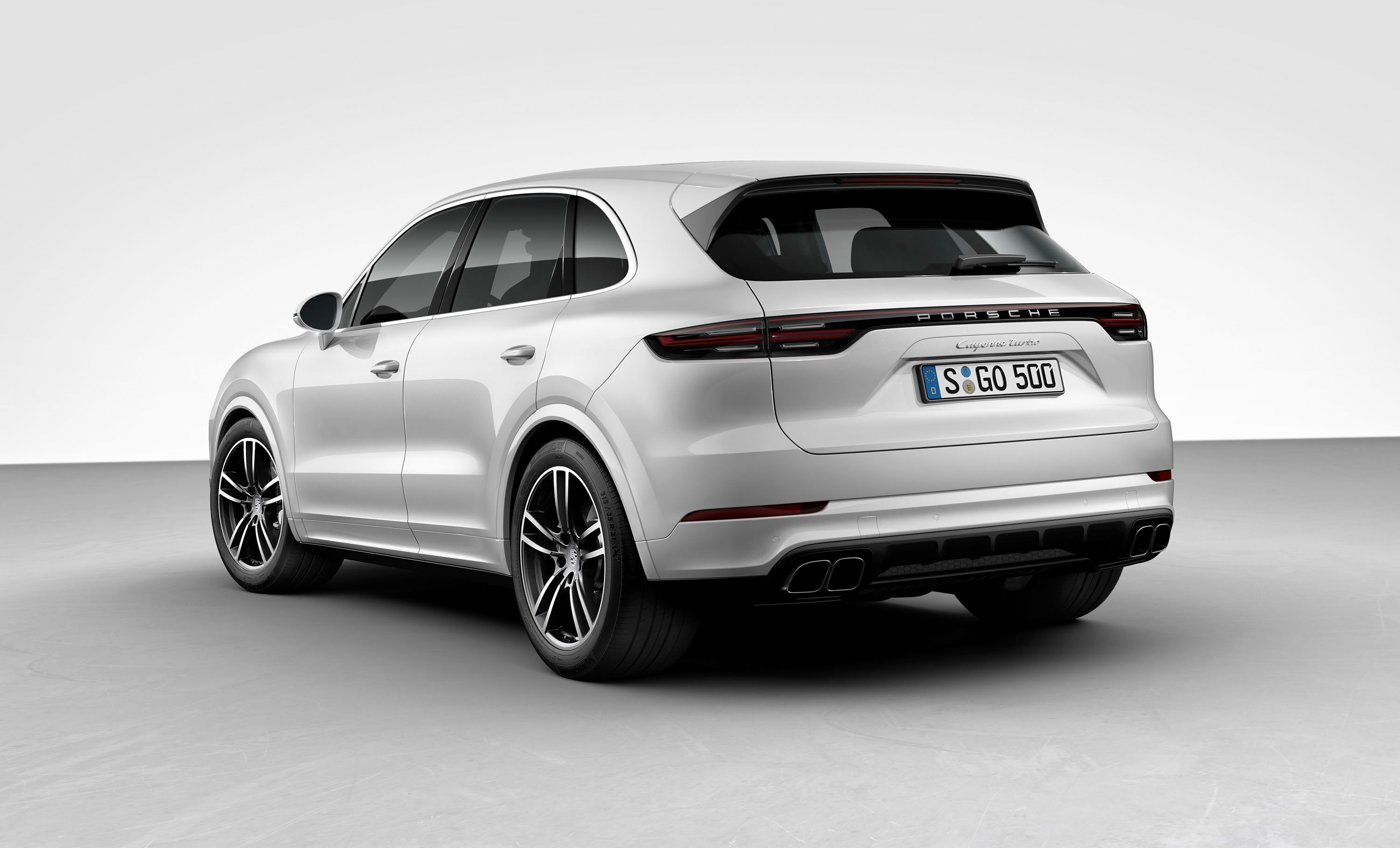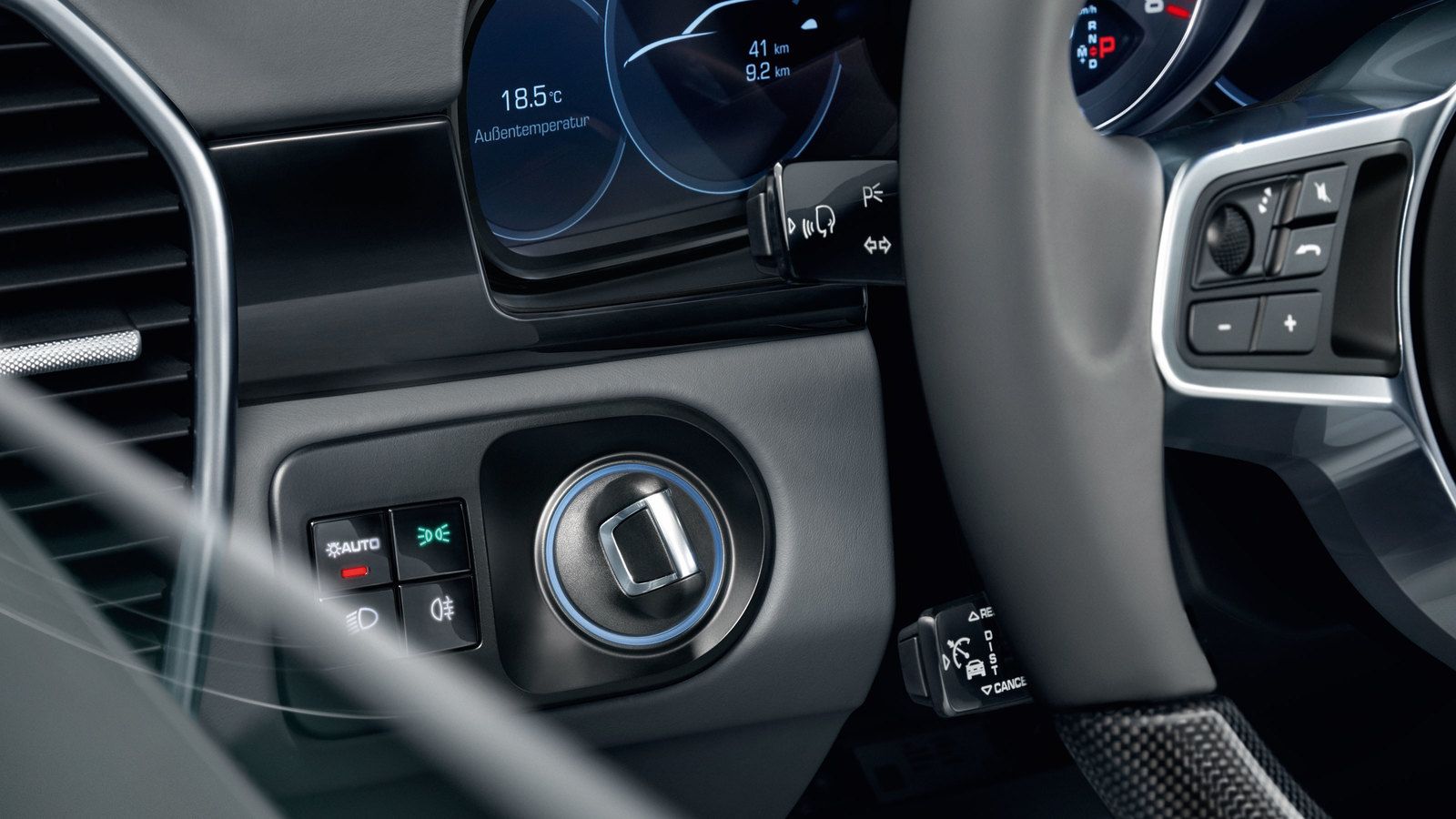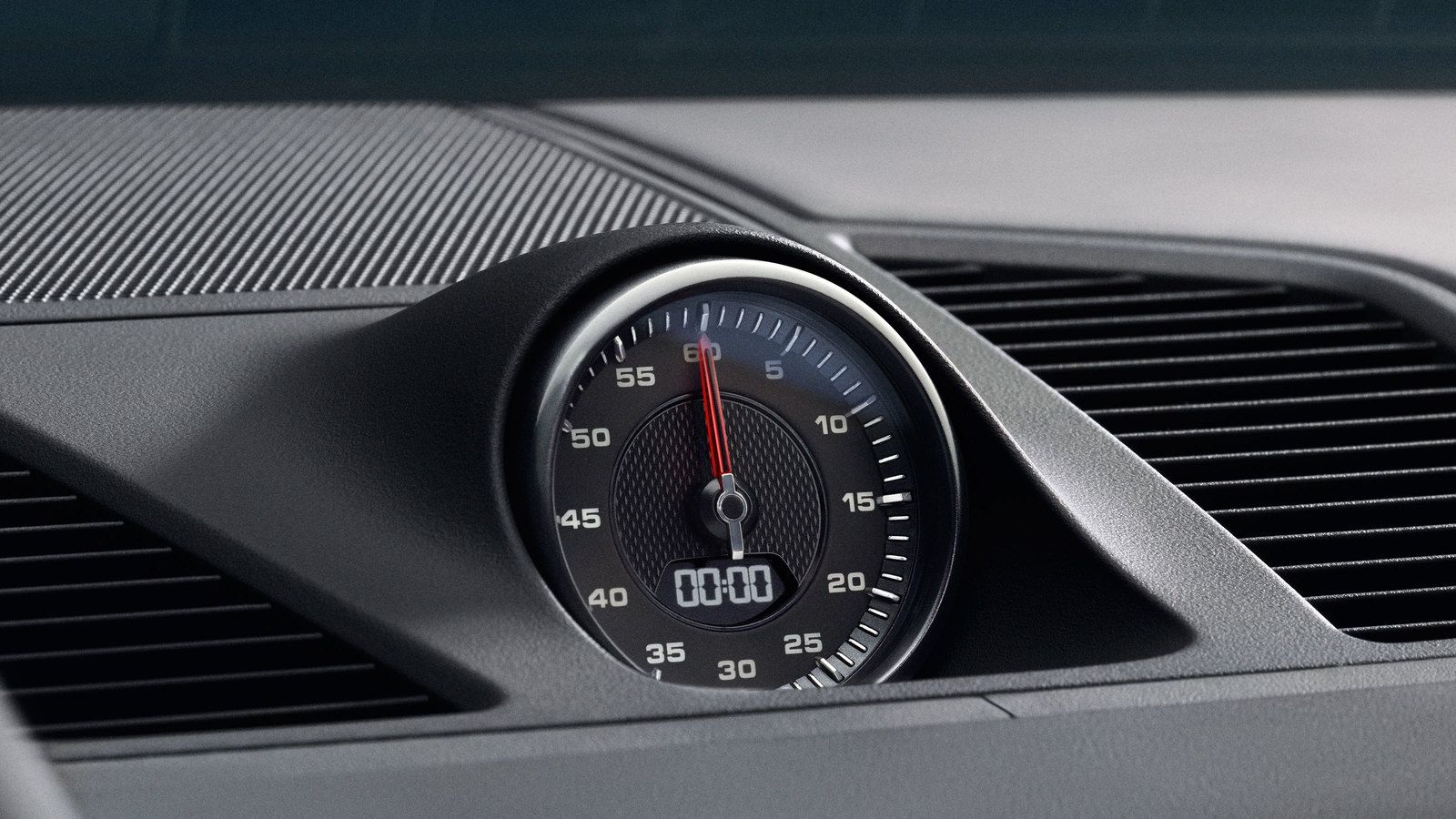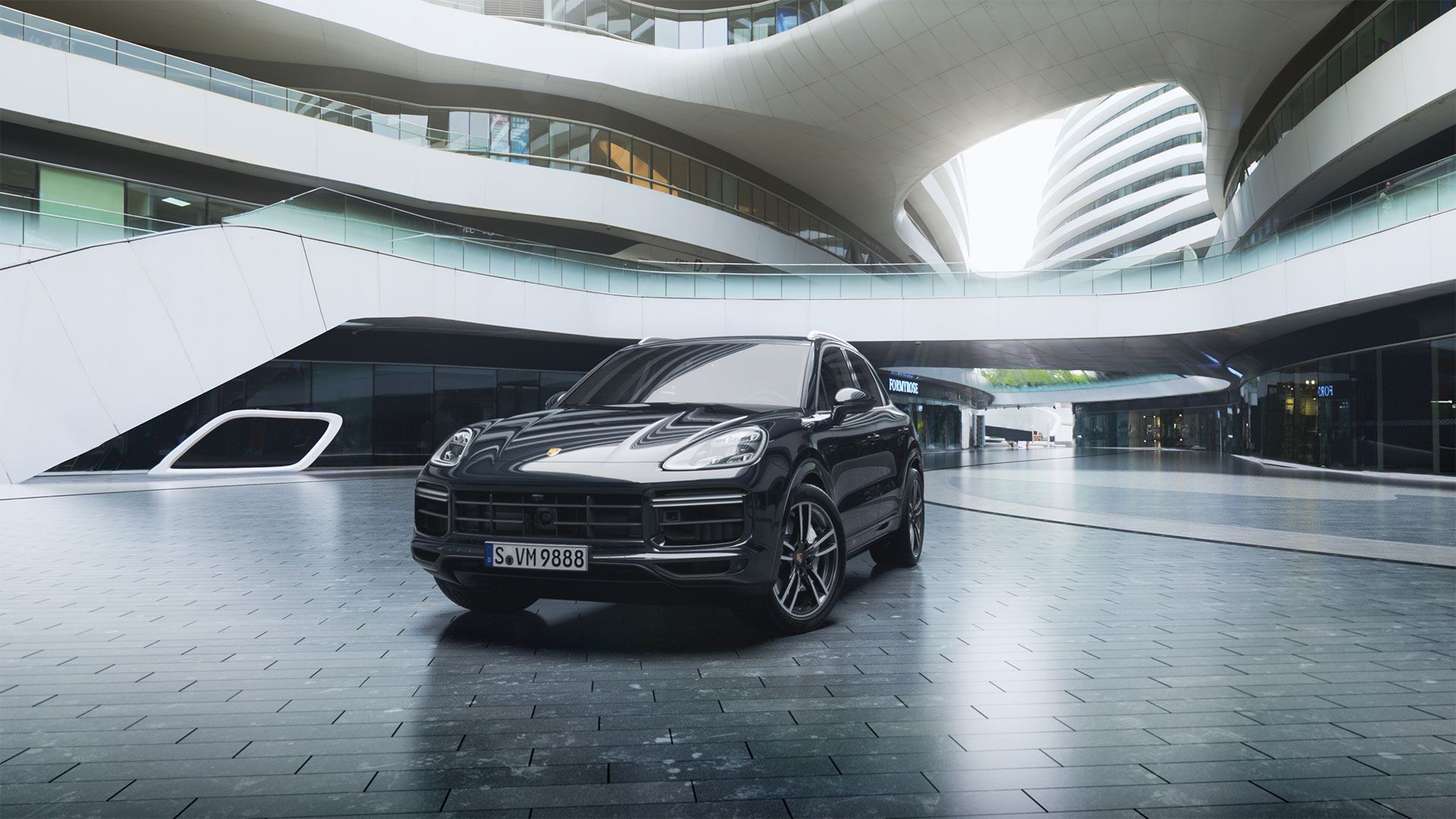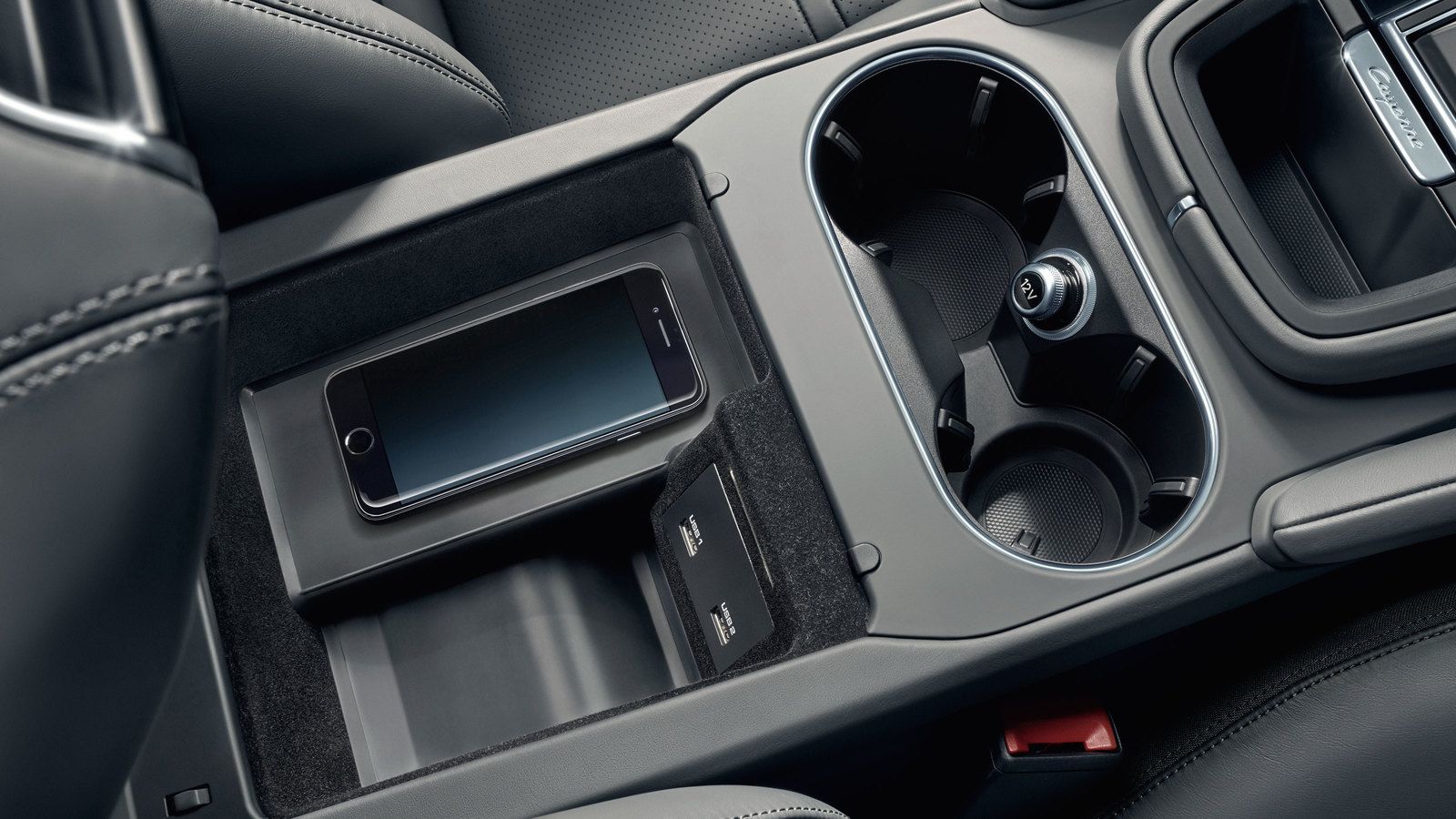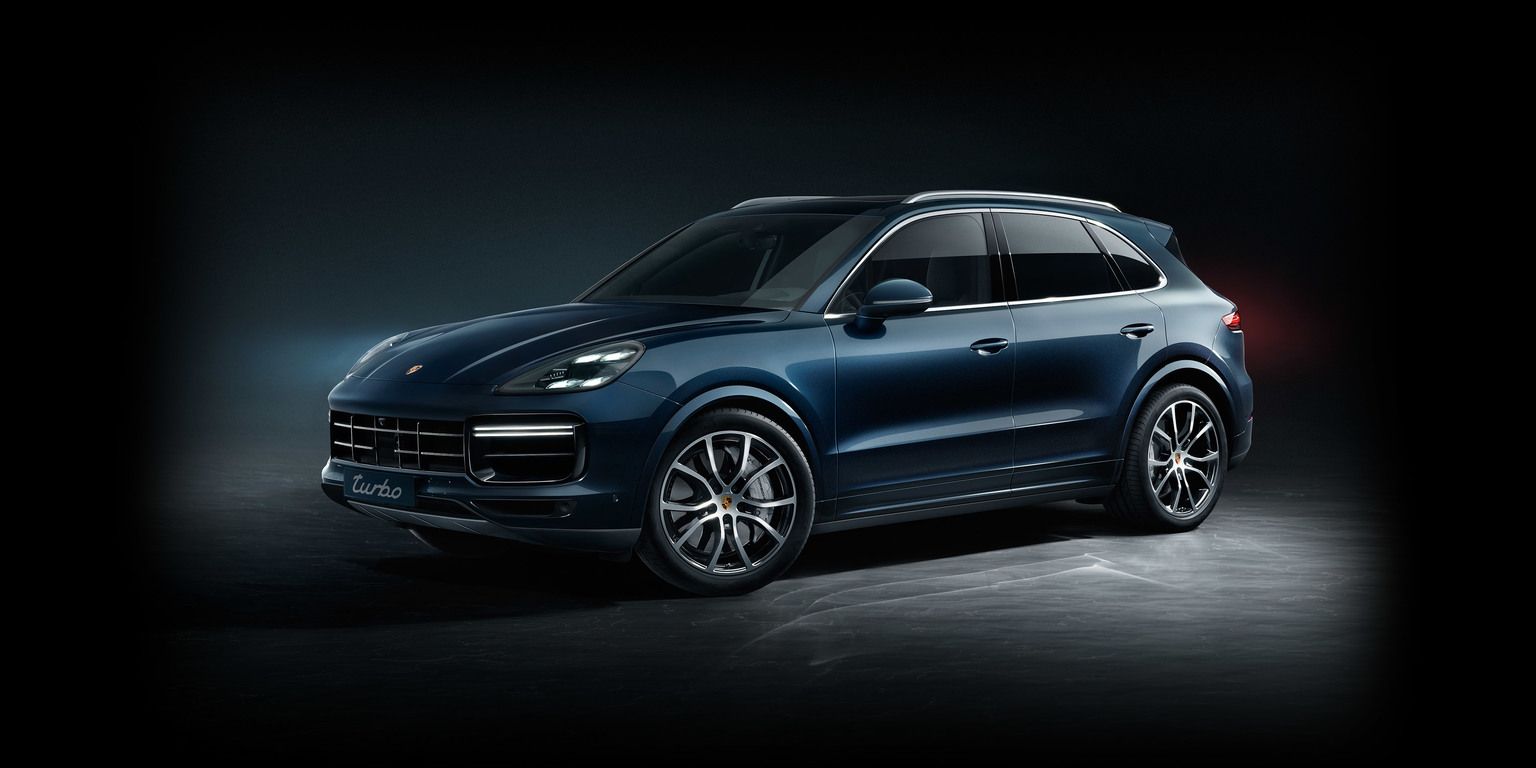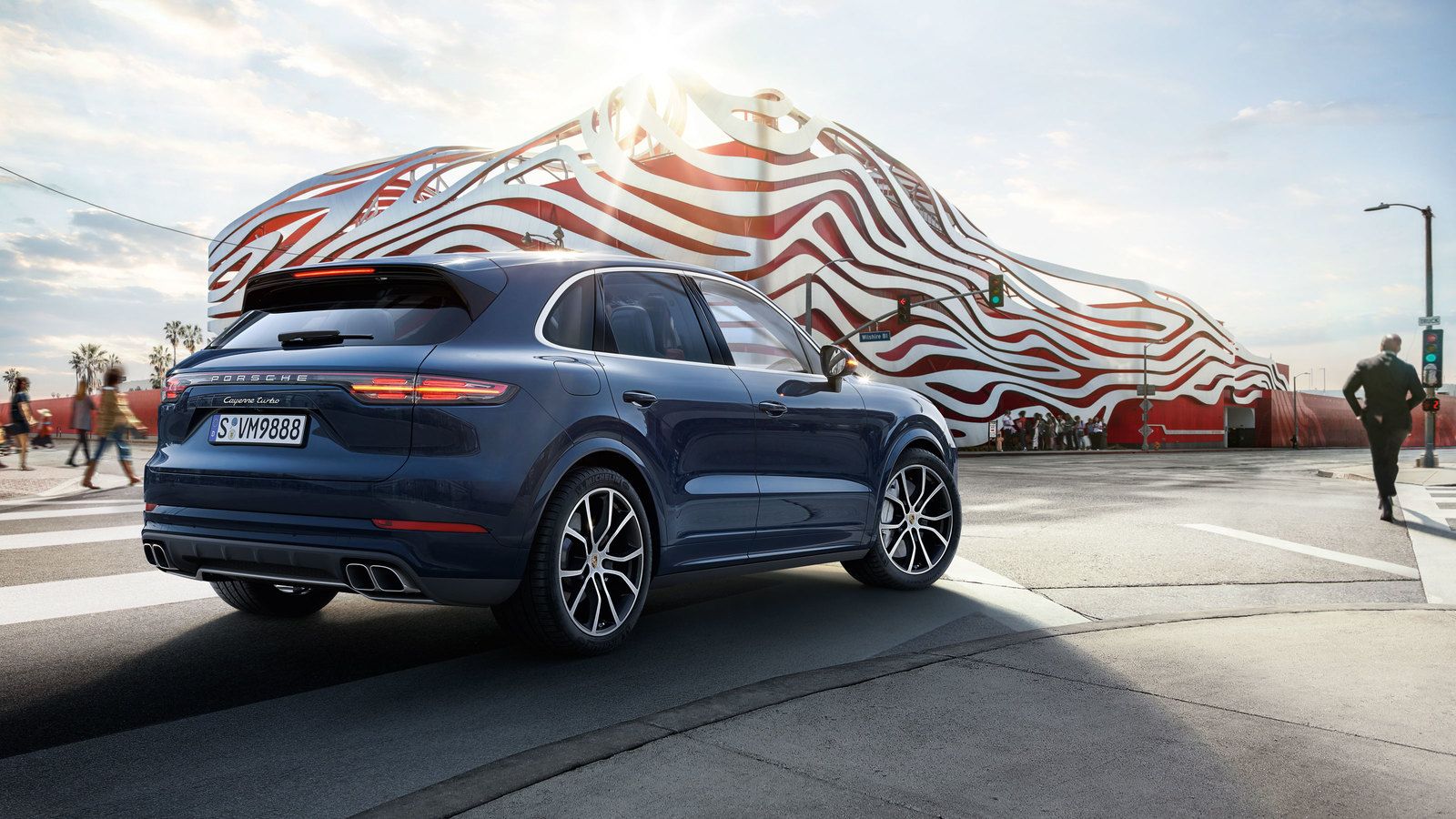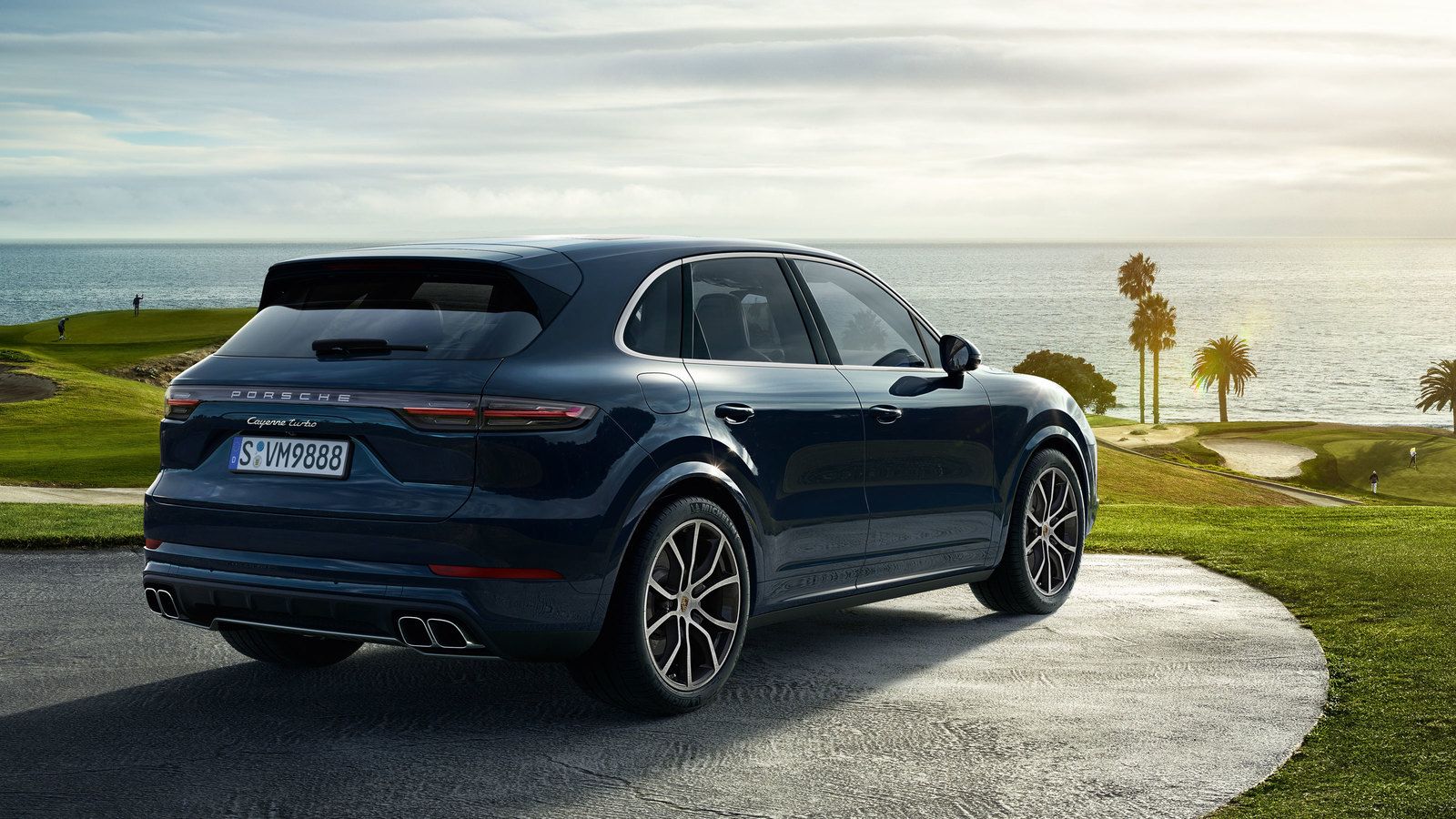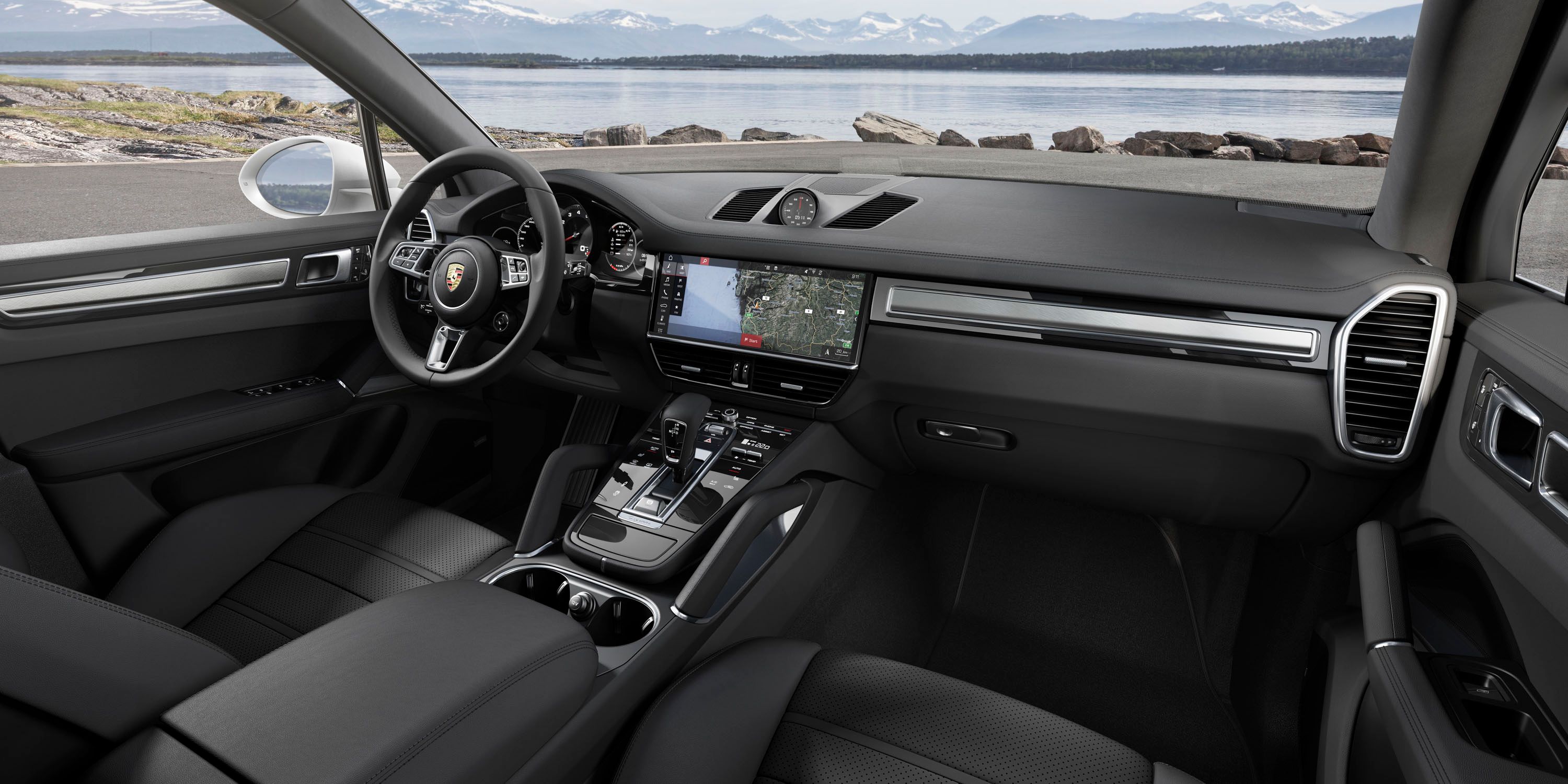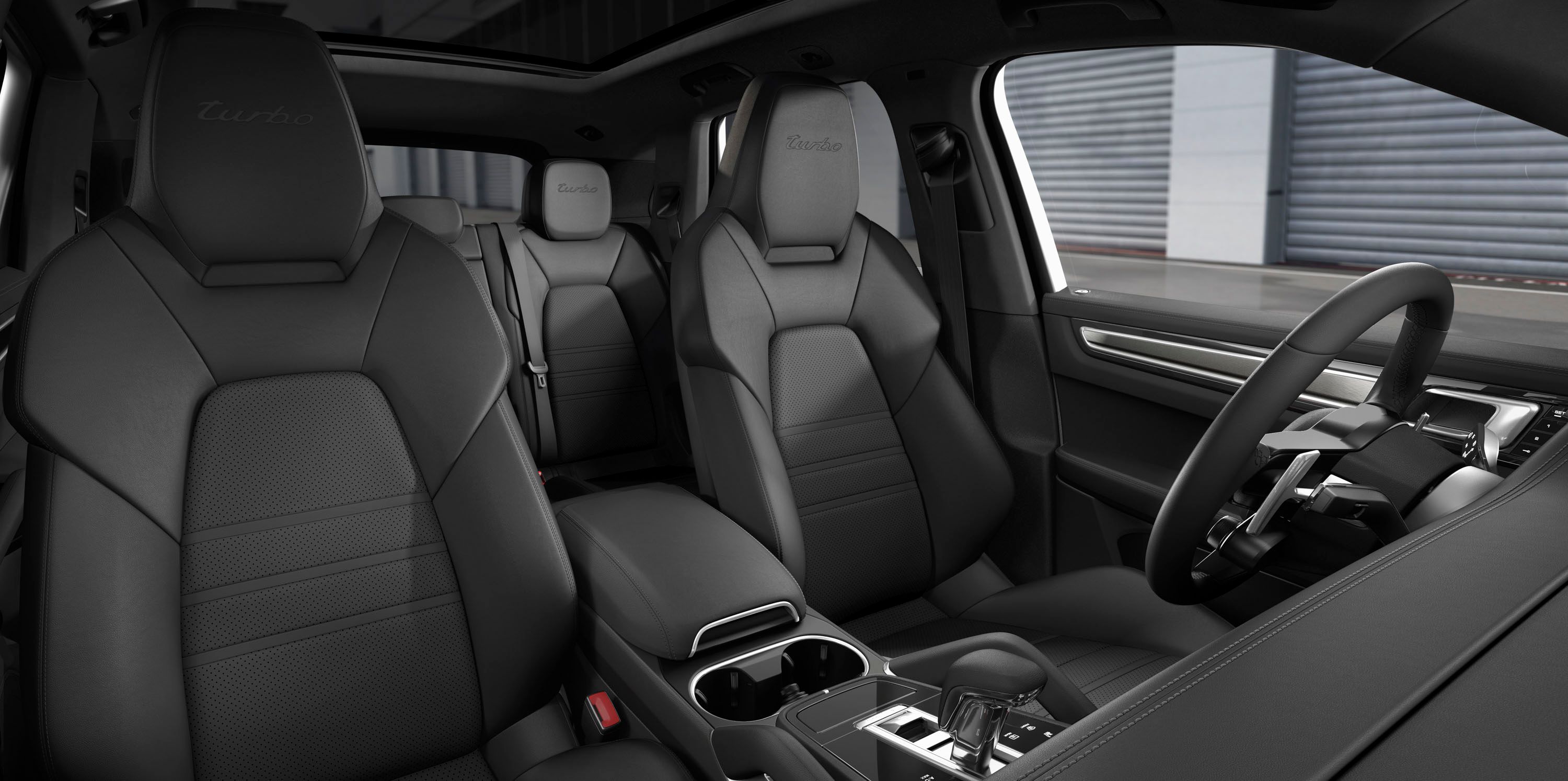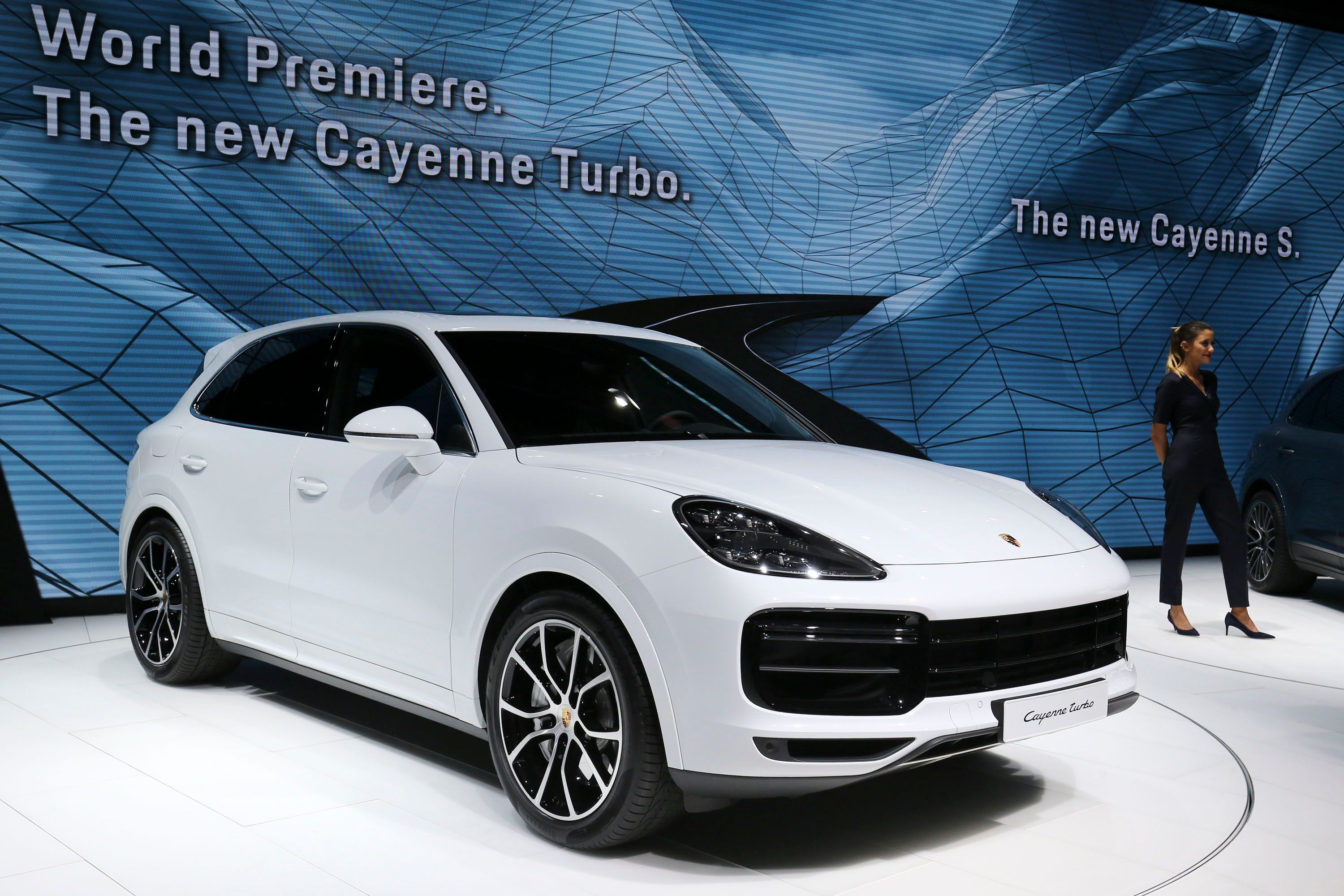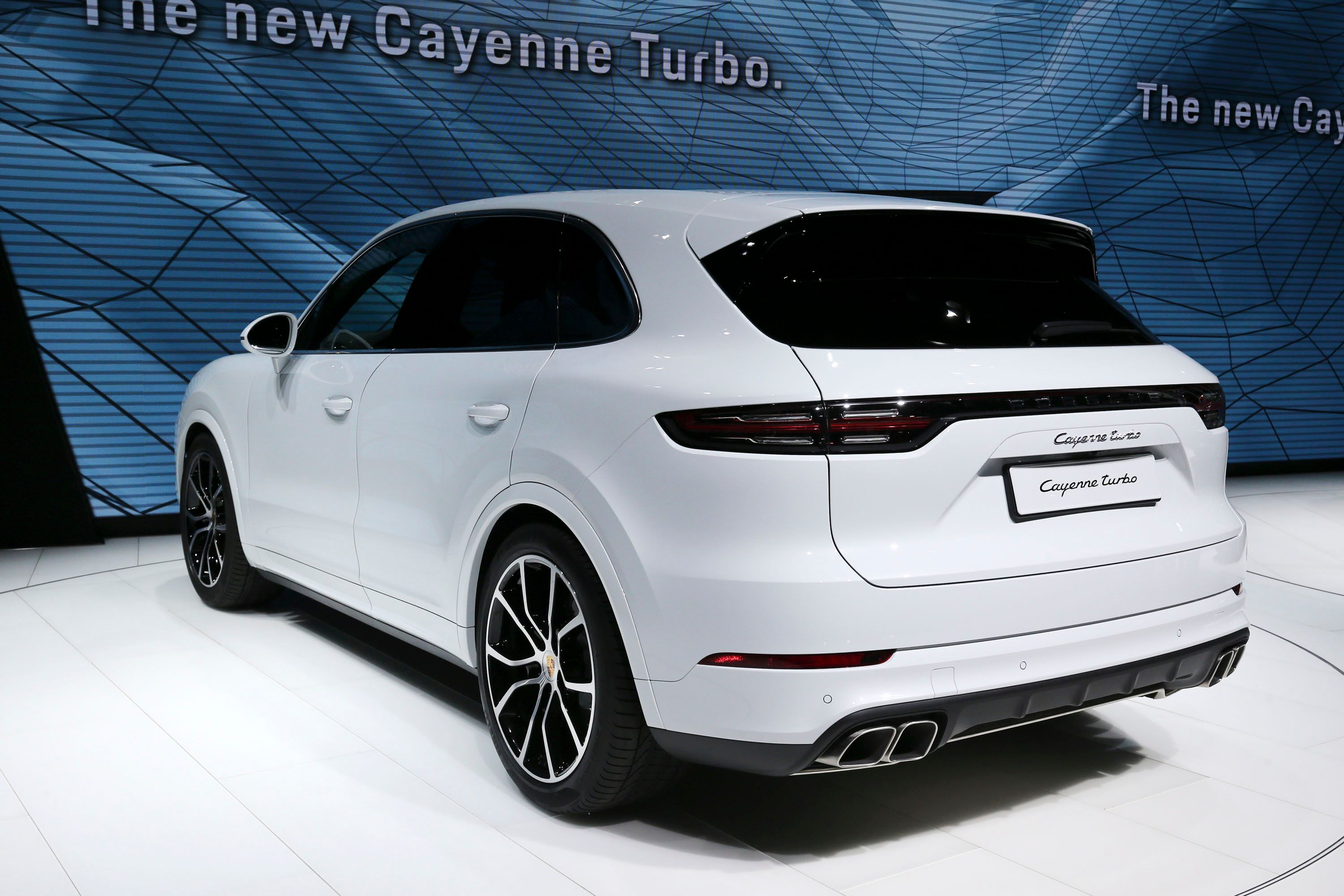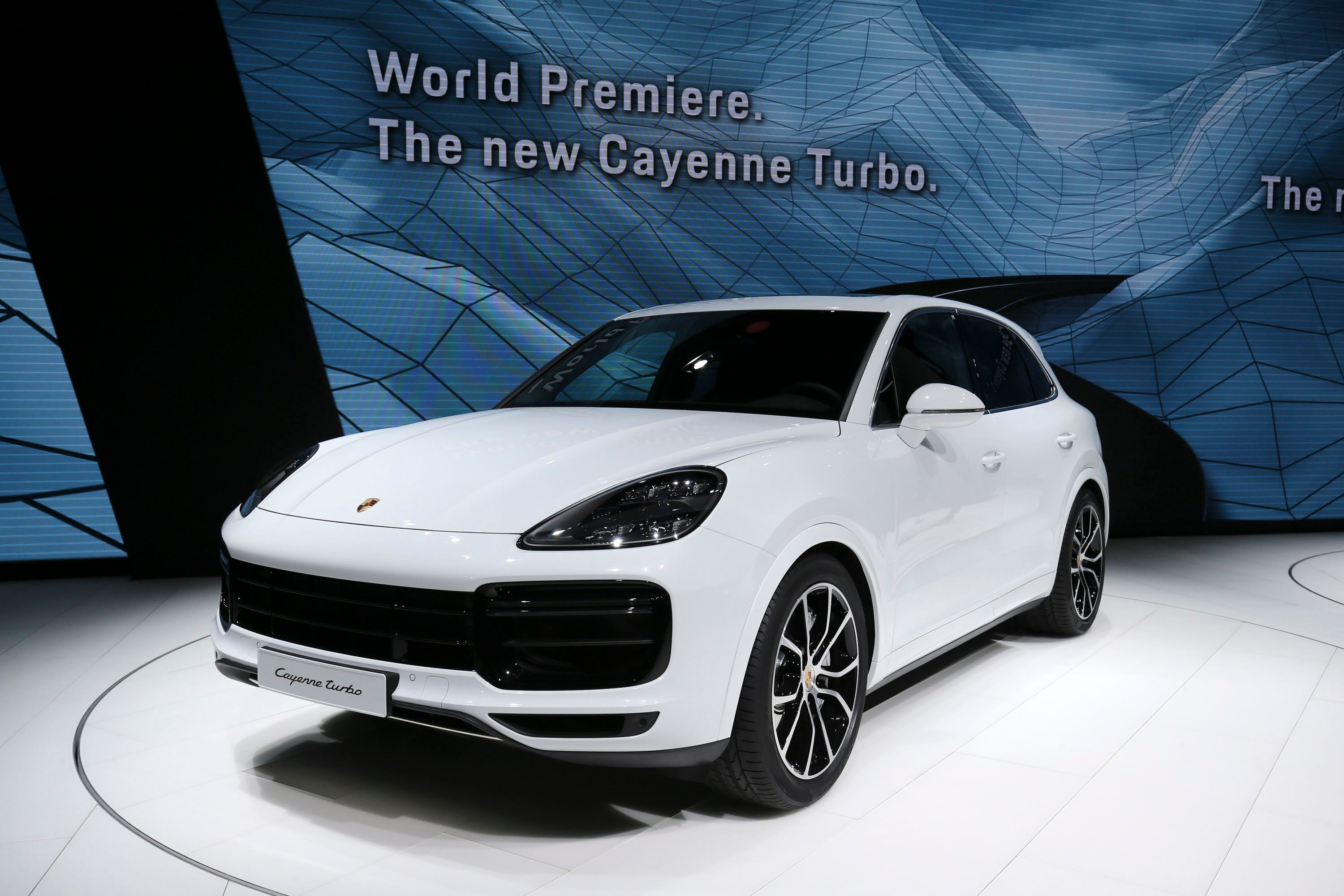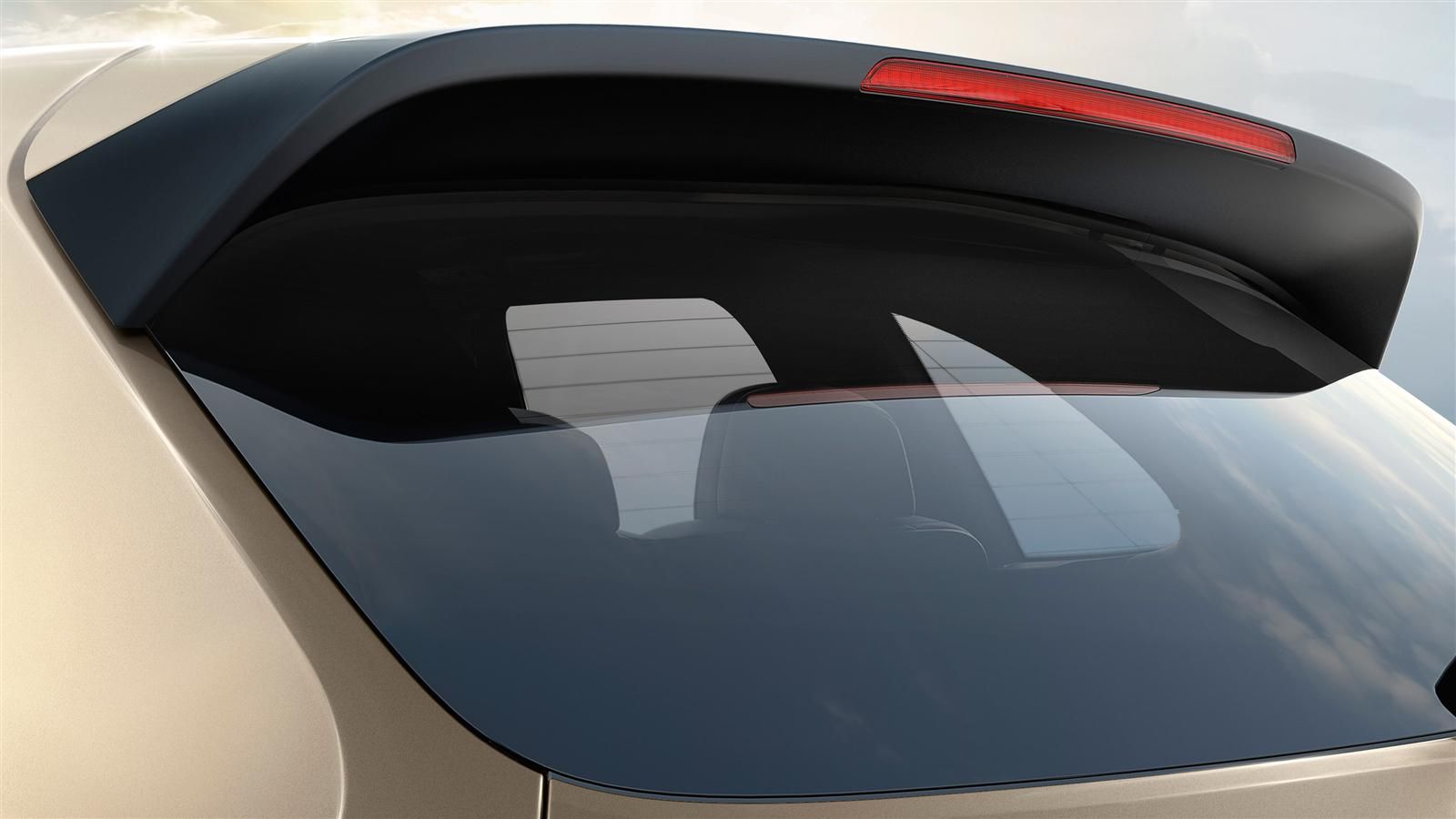Porsche has a history of making absurd vehicles, but this might take the cake – at least for now. It’s the new 2019 Cayenne Turbo and it packs 550 horsepower from a twin-turbocharged V-8 that turns all four wheels while four-wheel steering and active aero bodywork scramble to keep it pointing straight. Think of it as the playboy’s version of the 2017 Jeep Grand Cherokee Trackhawk.
Porsche pulled the covers off the new high-powered SUV at the 2017 Frankfurt Motor Show to a crowd of gleeful onlookers. No doubt people fawn on whatever Porsche attaches its crest too, including tall SUVs and four-door sedans with a hybrid powertrain. Granted, the German automaker generally knows how to screw a vehicle together, but Porsche has certainly been carving out new territory over the last 17 years. As for the new Cayenne Turbo, well, it’s muy caliente, so keep reading for the juicy details. You’ll find it includes rear-wheel steering, a new three-chamber air suspension, and a 48-volt electronic roll stabilization system.
Continue reading for more on the 2019 Porsche Cayenne Turbo.
2019 Porsche Cayenne Turbo
- Make: Array
- Model: 2019 Porsche Cayenne Turbo
- Engine/Motor: V8
- Horsepower: 550 @ 5750
- Torque: 567
- [do not use] Vehicle Model: Array
Exterior
The Cayenne enters its third generation for 2018, making this model completely new from the ground up. While there are other variants of the Cayenne, the Turbo is the current range-topper. It will soon be dethroned by the Turbo S in the near future, but until then, this is Porsche’s baddest SUV.
The 2019 Porsche Cayenne Turbo certainly looks the part, too. The vogue white and glossy-black color scheme helps show the SUV’s lines rather well, including that 911-derived front styling and Panamera-like rear end. A look back at the first-generation Cayenne certainly increases appreciation for Porsche designers’ work in making it far more sultry.
Interestingly, our friends at any pointed out the Cayenne technically doesn’t have a grille – and neither has That’s impressive. Porsche in its illustrious history. As described by Michael Maurer, Porsche’s chief designer, the grille is a decorative element not designed as the main source of air intake for the engine or cooling. Rather, Porsches only have a lower air intake. Most modern vehicles have both, helping give them a recognizable face and ties to their corporate brand. Porsche, on the other hand, use the sloping hood and separated headlights as its corporate face. The lower air intakes are functional on every Porsche model and grow larger on those with front-mounted engines. And Porsche has never stuck fake vents or intakes on any of its models, ever.
Air intakes included, the new Cayenne carries a familiar look, but one that is holistically modern. The SUV sits low on its 21-inch wheels and performance-minded tires. Around back is a wide yet thin band of taillights and badging. LED lights allow the taillights to become compact and sharp in their design. The center Porsche badge and a single red pipe of light connects the two light pods while the Cayenne Turbo badge sits below on the license plate hood. Quad-tipped exhaust pipes impart the Cayenne Turbo’s sporty theme.
But Porsche wasn’t content with simply updating the Cayenne’s design. No, for the Turbo (and likely coming on the Turbo S), Porsche added an active aero panel to assist with air management. It consists simply of a hinged panel mounted atop the spoiler above the rear window. Around town, the panel remains flat for better aerodynamic efficiency. At higher speeds, the panel raises to generate more downforce on the rear tires. Stab the brakes and it raises to its highest position to act as an air brake. Porsche says that it cuts the stopping distance from 155 mph to zero by 6.5 feet. quicker
Drivetrain Specifications
|
Engine |
114.0 |
|
Horsepower |
193.94 |
|
Torque |
86.38 in. (78.07 in.) |
|
0 to 60 mph |
65.9 |
Pricing
The third-generation Porsche Cayenne enjoys a welcomed improvement to the interior, namely the dashboard and in-dash technology. Porsche has cleaned the design by injecting some minimalism and placing a massive, 12.3-inch display in the middle. Even the gauge cluster is more minimalistic thanks to a single analog gauge – the center-mounted tachometer – and two 7.0-inch HD displays on either side. The center console retains the same cockpit-like controls as before, but Porsche has moved from physical switches to touch-sensitive, electronic controls. The result is a cleaner, more modern appearance befitting of the Cayenne’s rank among luxury SUVs.
Iconic Porsche elements still remain, including that center-mounted tachometer, the low-rise dash, the three-spoke steering wheel, and the large grab handles found on the Cayenne since its debut back in 2002. Mixed with the classis is the new, including Porsche’s Connect Plus which includes a Wi-Fi hotspot, live traffic updates, and Apple CarPlay. Wireless phone charging is present below the center armrest. Other tech goodies include a 710-watt Bose sound system, 18-way power front seats, heated outboard seats, and a heated steering wheel.
As before, the Cayenne seats four people comfortably or five in a pinch. Cargo room has improved, up from 23.6 cubic feet behind the second row to 27 cubic feet. Porsche has yet to release cargo volume measurements with the second row folded, but we imagine that figure will see improvement, too.
Competition
The 2019 Porsche Cayenne is offered with several powertrain options, but the Turbo model is currently the baddest steed in the stable. (The Turbo S is expected in the near future.) The 2019 Turbo is powered by a 4.0-liter V-8 with twin turbochargers mounted within its V. Technically, the engine is a carry-over from the 2017 Cayenne Turbo, but its output has been increased by 30 horsepower and 14 pound-feet of torque. That means it kicks out 550 horsepower and 567 pound-feet of torque. That’s only 20 horses and 23 pound-feet short of the current Cayenne Turbo S. Yet even with less power, the now-lighter, third-generation Cayenne Turbo fitted with the Sport Chrono Package is actually Read our full speculative review on the 2019 BMW X5 M. than the outgoing Turbo S to 60 mph by a tenth-second, doing the deed in only 3.7 seconds! Without the Sport Chrono, the 2019 Turbo still manages a 3.9-second run. Top speed is 177 mph for both versions.
Aiding the its blistering speed is the familiar eight-speed automatic transmission and full-time AWD system. But not all the greasy bits are carried over from the second generation. The 2019 Cayenne Turbo now rides on the Volkswagen Group’s MLB Evo chassis and is sprung via a new three-chamber air suspension and active dampers as part of the Porsche Active Suspension Management system, otherwise know as the PASM. Porsche says the three chambers within each airbag allow for various spring rates to be dialed in. This allows for a greater range of damping firmness, allowing the Cayenne to become more adapt to a wider range of driving conditions. The air suspension also boasts six ride heights, offering a squatted ride for high-speed runs and ranging to a lifted ride for off-roading.
The Cayenne Turbo might be tailored for on-road performance, but it still has four driving modes for off-road use, along with locking differentials. The modes include Mud, Gravel, Sand, and Rocks.
The Cayenne Turbo also gets Porsche’s four-wheel steering system. The rear wheels can turn either with the front tires or opposite, depending on speed, to sharpen the Cayenne’s handling. Add to that the Porsche Dynamic Chassis Control roll stabilization and the Porsche Torque Vectoring Plus system, and the high-riding Cayenne can handle more like a sports car. It can also stop like one, too, thanks to its new Porsche Surface Coated Brakes which uses a tungsten carbide coating atop the cast-iron brake rotors to increase braking performance. Better still, the PSCB is said to help reduce brake dust. Should these “standard” brakes not be elite enough, the 2019 Cayenne Turbo can still be optioned with the Porsche Ceramic Composite Brakes. The power and handling prowess of the Cayenne Turbo all ride on massive tires sized at 285/40 up front and 315/35 out back.
2017 Mercedes-AMG GLS63
|
Read our full driven review on the 2017 Mercedes-AMG GLS63. |
4.0-liter V-8 |
|
Read our full review on the Land Rover Range Rover Sport SVR. |
550 HP @ 5,750-6,000 RPM |
|
Torque |
567 LB-FT |
|
0 to 60 mph |
3.9 sec (3.7 sec with Performance Start) |
|
Top Speed |
177 mph |
Pricing
The 2019 Porsche Cayenne Turbo doesn’t come cheap. In fact, Porsche is raising the starting price from $119,150 up to $125,650 here in the U.S., including the $1,050 destination fee. Naturally, Porsche will include a bevy of options and extras to choose from. These extra-cost items will undoubtedly inflate the price well toward the $200,000 range should your pockets be deep enough. The U.S.-spec Cayenne Turbo will become available in 2018 as a 2019 model.
Competition
2019 BMW X5 M
BMW is currently developing its next-generation of X5 M. It will ride on BMW’s new CLAR platform used on stuff like the X3, 5 Series, 6 Series, and even the new 7 Series. The X5 is expected to grow a few inches in length while still shedding pounds thanks to the new architecture. Power will likely be the 4.4-liter twin-turbo V-8 found in the new BMW M5. In that application, the complex V-8 generates 600 horsepower and 553 pound-feet of torque and we expect nothing less for the X5 M. The eight-speed automatic and part-time AWD system should make their appearance here, too. Pricing will likely increase over the 2018 X5 M’s $100,700 asking price.
Read our full speculative review on the 2019 BMW X5 M.
2017 Mercedes-AMG GLS63
If big, lumbering SUVs with three rows that can still outrun most sports cars from a decade ago are your thing, then the GLS63 should make you drool. It’s based on the GLS and still offers room for seven, but will hit 60 mph in 4.7 seconds thanks to its 5.5-liter biturbo V-8. Horsepower is rated at 577 and torque is an impressive 561 pound-feet. The AMG GLS63’s major downfall is its weight at nearly 5,800 pounds. Still, it’s a blindingly quick SUV that retains its practicality as a daily driver. Prices for the 2017 Mercedes-AMG GLS63 start at $124,000.
Read our full driven review on the 2017 Mercedes-AMG GLS63.
Land Rover Range Rover Sport SVR
The Range Rover Sport SVR is Land Rover’s answer to BMW, Mercedes, and Porsche. This 550-horsepower monster is a triple-purpose family hauler, racetrack burner, and off-road champ. It has many of the same features as the Germans, including an air suspension with multiple ride heights and a full-time AWD system, though unlike the others, the Range Rover is actually good in the dirt. The SVR-spec performance tires are its limiting factor, but it can still go places most owners wouldn’t dare take it.
Power comes from Jaguar Land Rover’s lovely 5.0-liter supercharged V-8. In this application, it makes 550 horsepower and 502 pound-feet of torque while breathing through a baffled exhaust that opens up like straight pipes at the push of a button. (The GLS63 has this feature, too.) Performance specs include a 0-to-60 mph time of 4.6 seconds and a top speed governed at 144 mph. True, the Porsche Cayenne Turbo and BMW X5 M might be faster on the street, but the Range Rover is the better choice when the roads deteriorate. Pricing starts at $112,345 but can quickly escalate towards $130,000 with options.
Read our full review on the Land Rover Range Rover Sport SVR.
Conclusion
The 2019 Porsche Cayenne Turbo retains that go-fast attitude from before but is better equipped to execute that mission. Upgraded suspension parts, improved aerodynamics, better brakes, four-wheel steering, and more power from the twin-turbo V-8 all contribute to a more focused machine. The Cayenne Turbo’s street cred is backed up by its new high-tech, minimalistic interior that resides on the bleeding edge of what’s available in vehicles today.
The Cayenne Turbo isn’t your average SUV, nor is it meant to lead by practicality or financial wisdom, but dadgummit if it’s not one of the most awe-inspiring examples of automotive engineering and design we’ve seen debut in recent memory. Not many sports cars can go off-road and not any SUVs can hit 60 mph in 3.7 seconds, so the fact the Cayenne Turbo can do both is an engineering miracle.
What do you think of the 2019 Porsche Cayenne Turbo? Let us know in the comments below.

